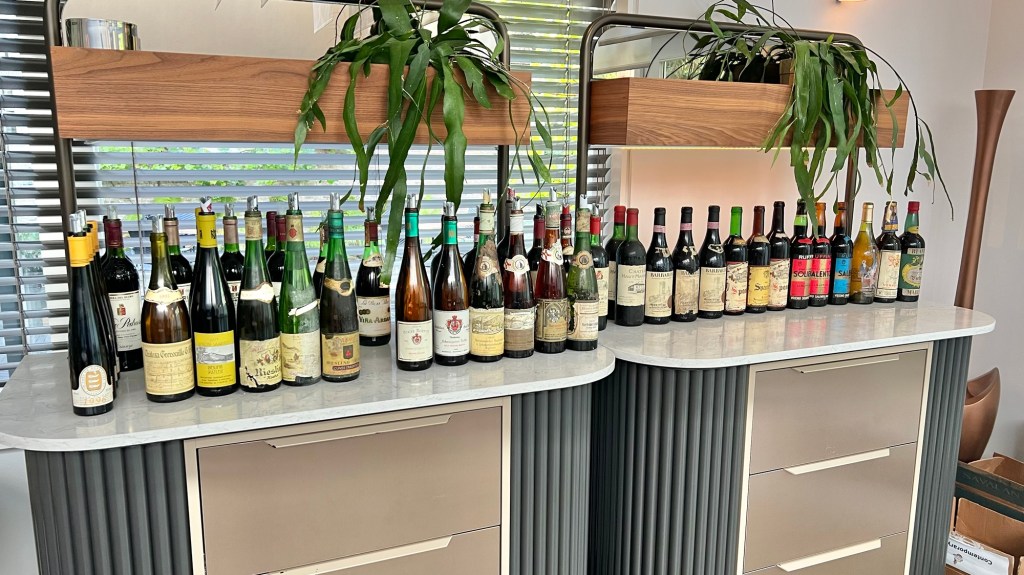
This was a very special wine lunch at In Den Rustwat (IDRW) in Rotterdam, organized by Fred Nijhuis. Fred is a wine writer who specializes in Italy and was the guide for the wine trips to Lombardia, Piemonte, and Campania. For this wine dinner he selected 37 bottles of old and very old vintages, all from the previous century, ranging from 1999 to as far back as 1953! Fred calls these dinners Ouwe meuk of oude meesters, which can be translated to something like “Old pieces of shit, or old masterpieces”. This is because many of those bottles may be way past their prime (and thus an old piece of shit), but some may turn out to be a masterpiece that still stands after all those years.
It is often said that wines improve (and become more valuable) with age. This is not true for the vast majority of wines (certainly not for most you can buy at the supermarket), and even wines that can or even need to age, will reach a peak and then start to decline. Wines with more tannin, acid, and especially sugar tend to age the best.
Since the wines weren’t really paired with the food, I’m describing the food and the wines separately. The wines were organized in 6 flights of 6 wines (with one bonus wine in the 4th flight), making a total of 37 wines. There was also a nice sparkling metodo classico from Veneto to start with.
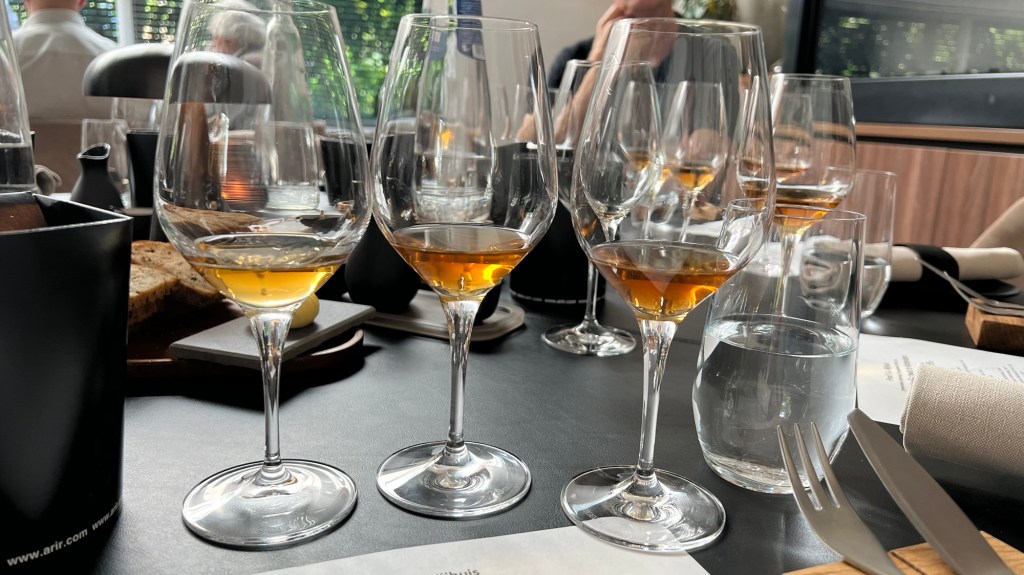
The first flight was a mix of dry Rieslings and some miscellaneous wines. Notice the color of these white (!) wines. All wines, both white and red, ultimately end up with a brown color.
- Pazo de Barrantes, Albariño, Rias Baixas, Spain, 1996, half bottles: the bottles were quite different, one of them had a very nice caramel aroma.
- Château Grenouille, Chablis Grenouille Grand Cru, France, 1995: full-bodied, balanced, nutty, like an Amontillado sherry.
- Schloss Saarstein, Riesling Spätlese, Saar, Germany, 1993: nice aroma, still fresh but not very complex
- Kuehn, Riesling, Alsace, France, 1982: brown color, acidic
- Jean Paul Hüber, Gewurztraminer Kaefferkopf, Alsace, France, 1982: straw yellow, understated gewurz aroma, light-bodied, but still standing
- Hugel, Riesling Cuvée Tradition, Alsace, France, 1982: gone
Riesling has a reputation for aging well, but the Gewurz had aged a lot better than the two Alsace Rieslings from the same vintage. The Albariño demonstrated that bottles from the same vintage, even if from the same case and stored together under the same circumstances, can age quite differently. Smaller bottles age more quickly than larger bottles, because they get more oxygen relative to the amount of wine.
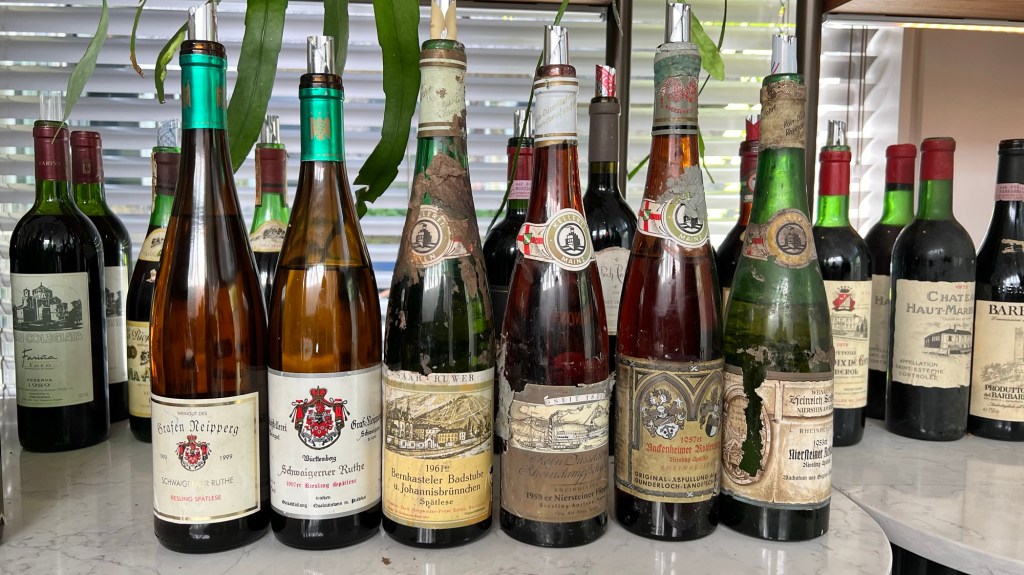
The second flight were 5 sweet and 1 dry Rieslings from Germany:
- Graf von Neipperg, Schwaigerner Ruthe Riesling Spätlese, Württemberg, 1999: aroma of lovage, sweet & sour, fresh
- Graf von Neipperg, Schwaigerner Ruthe Riesling Spätlese trocken, Württemberg, 1997: acidic, old.
- Zach-Bergweiler-Prüm Erben, Bernkastler Badstube & Johannisbrünnchen, Riesling Spätlese, Mosel, 1961: sherry.
- Kellerei Mainz, Niersteiner Hipping Riesling Auslese Natur, Rheinhessen, 1959: unbelievable that this wine is 65 years old, seems young, fresh, nice balance between sweetness and acidity, mint aroma.
- Gunderloch Lange’schen Gut, Madenheimer Rothenberg Riesling Spätlese, Rheinhessen, 1957: brown, acidic, old.
- Heinrich Seebirh, Niersteiner Rehbach, Riesling Spätlese, Rheinhessen, 1953: not as nice as the 1959, but remarkably fresh and fruity for a 71-year old wine.
This flight demonstrates the power of sugar for preserving wine, as sweet Rieslings from the 50ies had held up better than dry Rieslings from the 80ies in the previous flight as well as the dry Riesling from the 90ies in this flight. It would be fun to include the 1959 Riesling in a blind tasting and ask the vintage — I bet that many (including myself) would guess a vintage from this millennium and be off by 40 years or so.
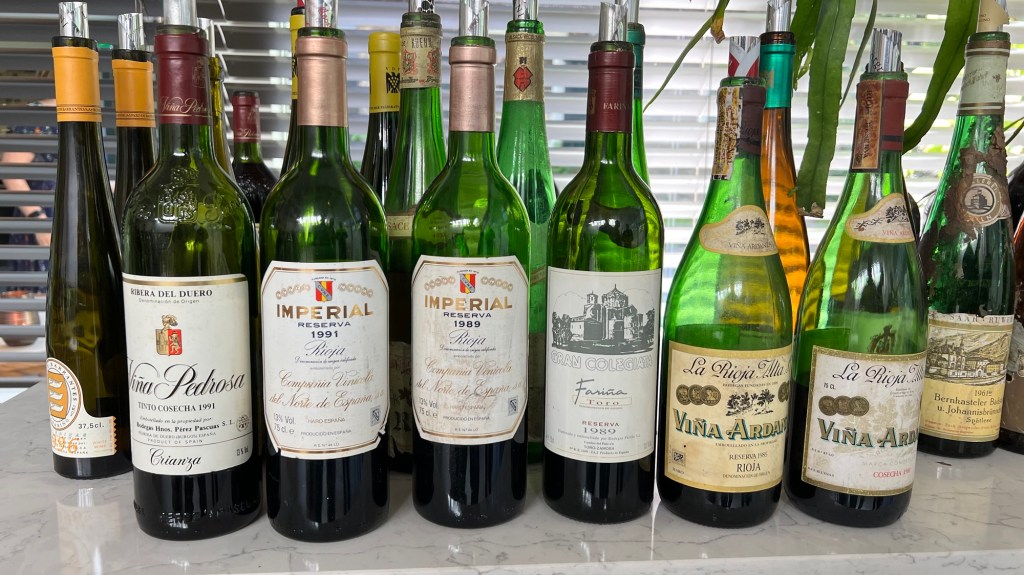
The third flight was red wines from Spain:
- H.nos Perez Pascuas, Viña Pedrosa, Ribera del Duero Crianza, 1991: beautiful fruit aroma, still quite a lot of tannins, acidity, fresh.
- CVNE, Imperial Rioja Reserva, 1991: oak, fresh, light-bodied, acidic.
- CVNE, Imperial Rioja Reserva 1989: more body and tannin, than the 1991, but less complex.
- Fariña, Gran Colegiata, Toro Reserva, 1989: still a lot of color (Toro is known for having deeply colored reds) and tannin, mint aroma.
- La Rioja Alta, Viña Ardanza, Rioja Reserva, 1985: complex aroma with some caramel, brown-red color, acidic.
- La Rioja Alta, Viña Ardanza, Rioja Reserva, 1981: brown-red color, still a lot of tannin, acidic.
This flight shows that these Spanish reds can age for 40 years or so, although I think all of them were better when they were younger.
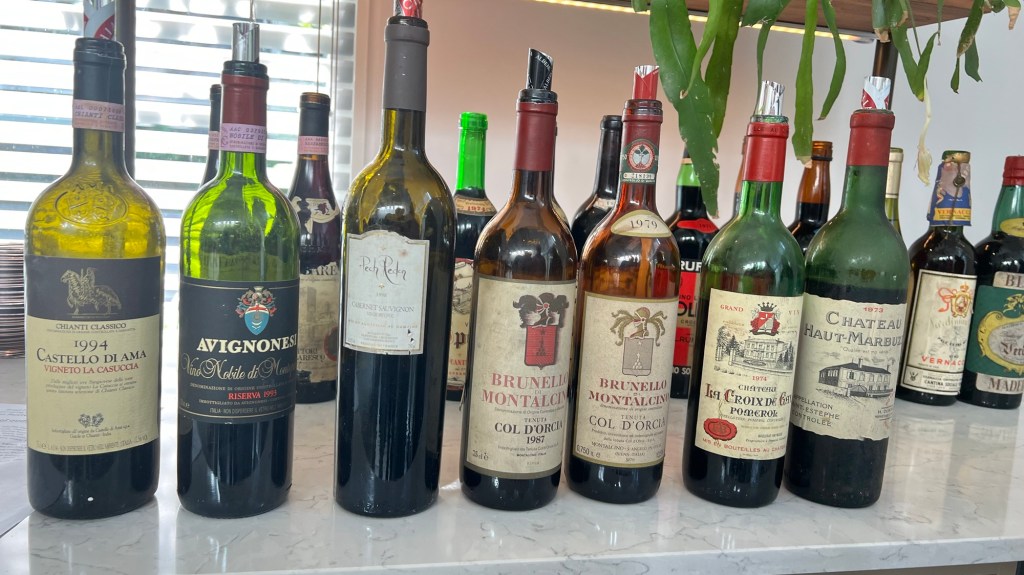
The 4th flight was a mixture of Tuscany (Italy) and France, with a Pomerol from ‘my’ vintage 1974 as a bonus:
- Castello di Ama, Vigneto la Casuccia, Chianti Classico, 1994: light color, fresh, soft tannins, seems much younger.
- Avignonesi, Vino Nobile di Montepulciano Riserva, 1993: more color than the Chianti, quite a bit of tannins and acidity, developed aroma.
- Pech Redon, Cabernet Sauvignon, Vin de Pays d’Oc, 1988: lot of color and tannin, pencil aroma.
- Col d’Orcia, Brunello di Montalcino, 1987: light, acidic, mint aroma.
- Col d’Orcia, Brunello di Montalcino, 1979: still quite a bit of body with tannins and acidity.
- Château Haut-Marbuzet, Saint-Estèphe, 1973: old, acidic

The Château La Croix de Gay, Pomerol, 1974 deserves a separate photo only because it is from ‘my’ vintage. No surprises there, I already knew very well that 1974 does not have a good reputation in France or Italy, and this was no exception: old and acidic.
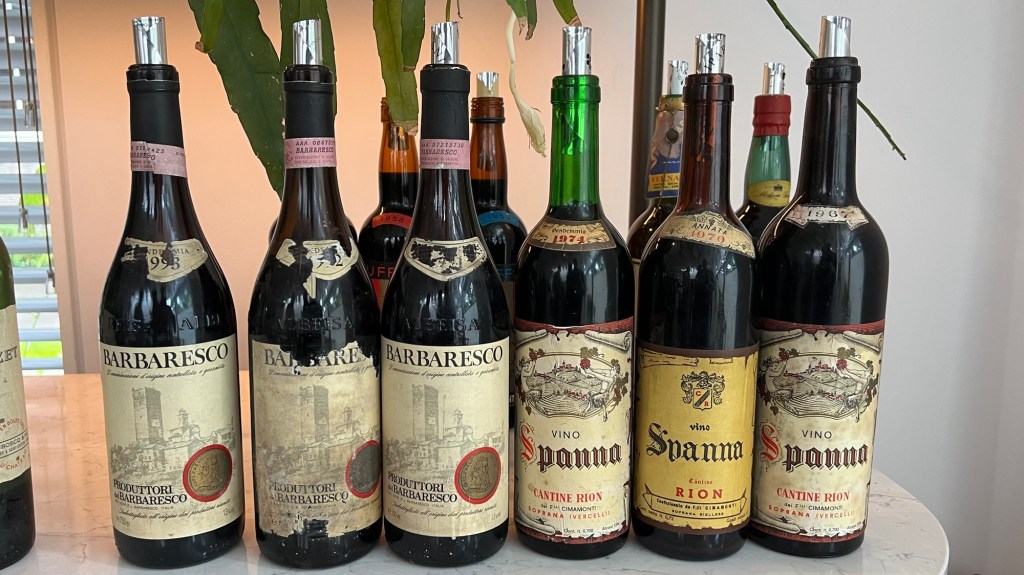
The final red flight is all Nebbiolo from Piemonte, Italy. Spanna is a synonym used for Nebbiolo in Alto Piemonte.
- Produttori del Barbaresco, Barbaresco, 1993: light-bodied, acidic, aroma of pencil
- Produttori del Barbaresco, Barbaresco, 1992: a bit more body than the 1993, but otherwise very similar
- Produttori del Barbaresco, Barbaresco, 1991: aroma of sour cherries, tannin still present
- Cantine Rion, Spanna, 1974: brown-red, acidic
- Cantine Rion, Spanna, 1970: brown, aroma like madera
- Cantine Rion, Spanna, 1967: brown, aroma like madera
As the Spanna from Gattinara (Alto Piemonte) from 1957, ’58, and ’61 were the Old Masters of the previous Ouwe Meuk dinner, it was a bit disappointing that this time around, they were more or less gone. It was also clear that 1991 was a better (if not great) vintage than 1992 and 1993 for the Barbaresco. So even though it is 1-2 years older, the 1991 was more alive than the ’92 and ’93. It was really nice to be able to do a vertical tasting of such old Produttori wines, although of course it would even have been nicer to do so with better vintages.

The final flight was mostly fortified wines:
- Ruffino, Croce d’Oro, Vecchio Salento Bianco, 1971, dark brown, sweet and sour
- Ruffino, Croce d’Oro, Vecchio Salteno Bianco, 1958, dark brown, sweeter but therefore more balanced, more full-bodied and more complex than the ’71
- Ruffino, Croce d’Oro, Vecchio Salento Rosso, 1959, dark brown, more acidic than the other two, and with a bit of an ‘ouwe meuk’ aroma
- Caveau des Byards, Cuvée du Bicentenaire, Côtes de Jura, NV, golden colored, quite acidic
- Cantina Sociale Vernaccia Oristano, Sardinian Gold, Vernaccia di Oristano Pale Extra Dry, NV, amber colored, old
- Blandy’s, Duke of Cambridge, Verdelho Medium Sweet Madeira, NV, brown, sweet and sour
Ruffino is a producer from Chianti in Tuscany that here has used grapes from Puglia to make the sweet fortified wines. They were aged in wooden casks and bottled later. A bit like PX, but less sweet, and more acidic. The Jura improved a bit with white-mold or Comté cheese. Vernaccio di Oristano is similar to sherry and from Sardinia. Since it is NV the age is unknown, but this one seemed to have aged a bit too much. The same goes for the Madeira.
This was another very interesting tasting session of very old wines. There were only a few wines that I would have liked to finish a glass (or bottle) of, but it was certainly a great experience. Fred mentioned that his supply of old wines is running low, so it’s unsure when or if there is going to be a next session.
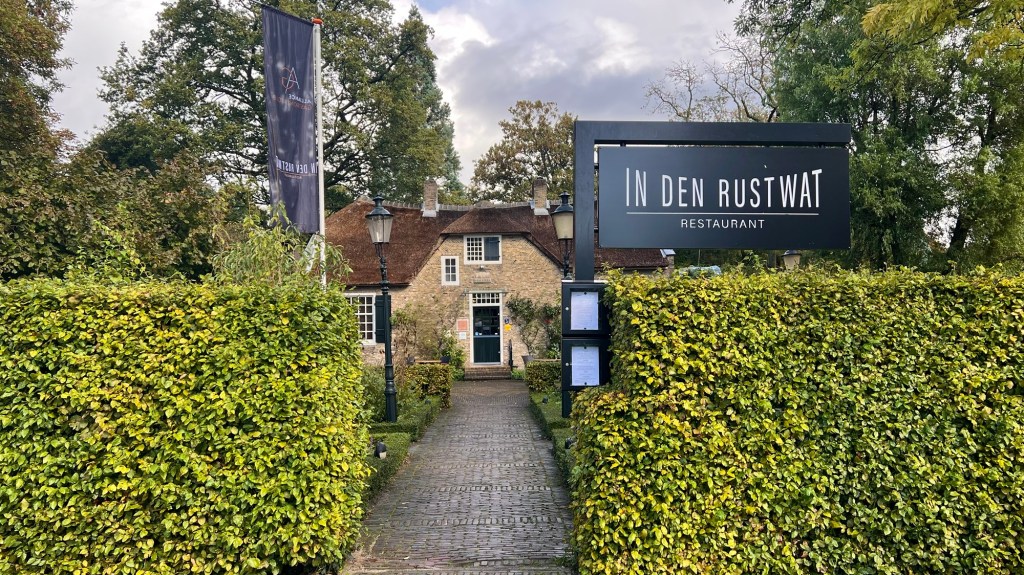
Now now for the food. If you see this photo, it is hard to believe that IDRW by chef Marcel van Zomeren is located within the city of Rotterdam. Rotterdam was almost completely destroyed in 1940, but the restaurant is located inside this inn from 1597. We had the 5-course Alliance tasting menu (85 euros). The food you see in this blog is what you will also get if you go to the restaurant (until the menu changes, obviously), but the wines were brought by Fred and are not on the wine list of the restaurant.
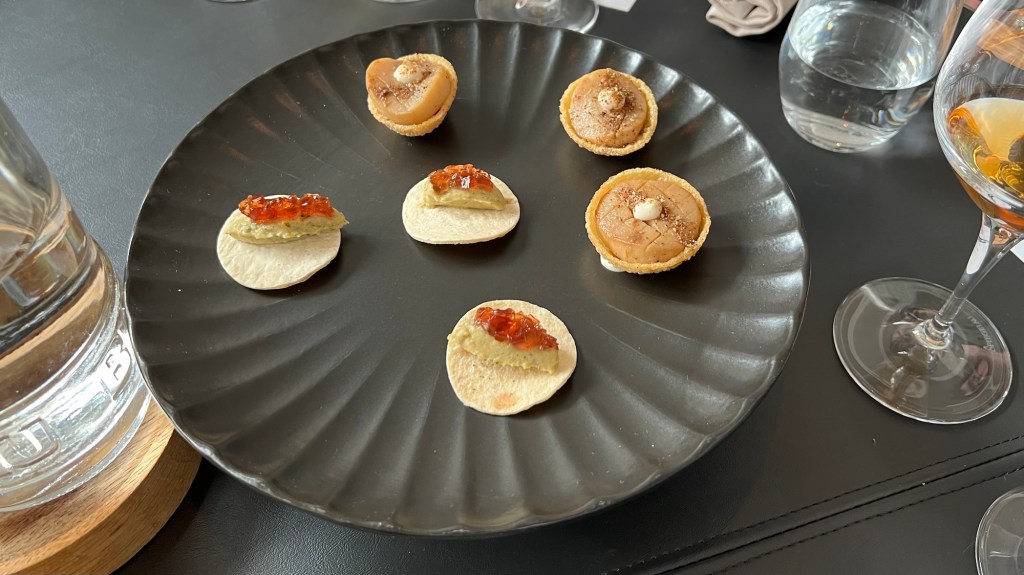
We started with two amuses: a tortilla with zucchini hummus (that according to the explanation also included orange and mint, but I couldn’t taste those) and a very nice kimchi soufflé with porcini mushroom.
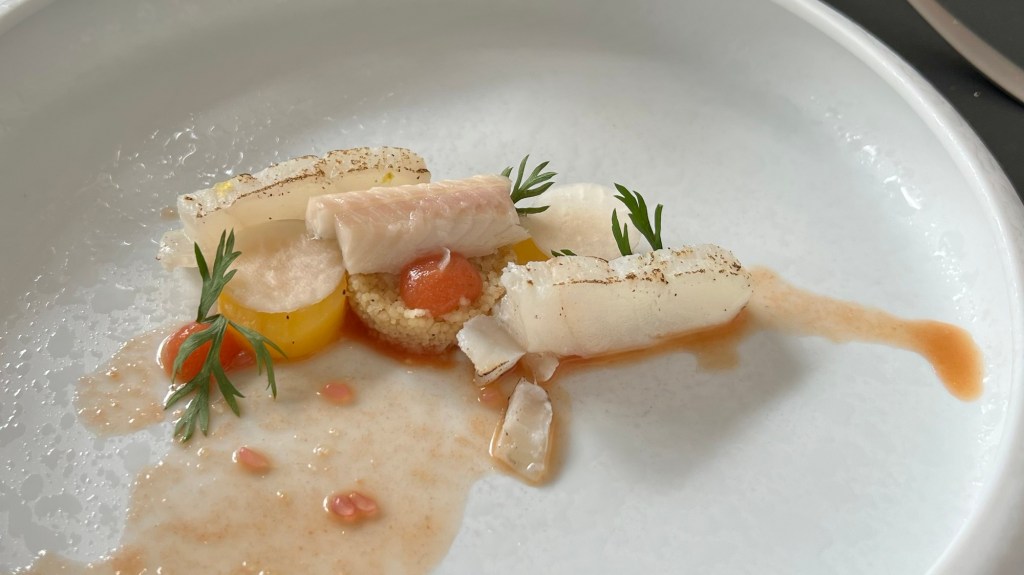
Next was haddock with smoked eel, kohlrabi, tomato, and couscous. The fish had a perfect cuisson, but this was my least favorite dish of the menu because I didn’t really get the combination of components.
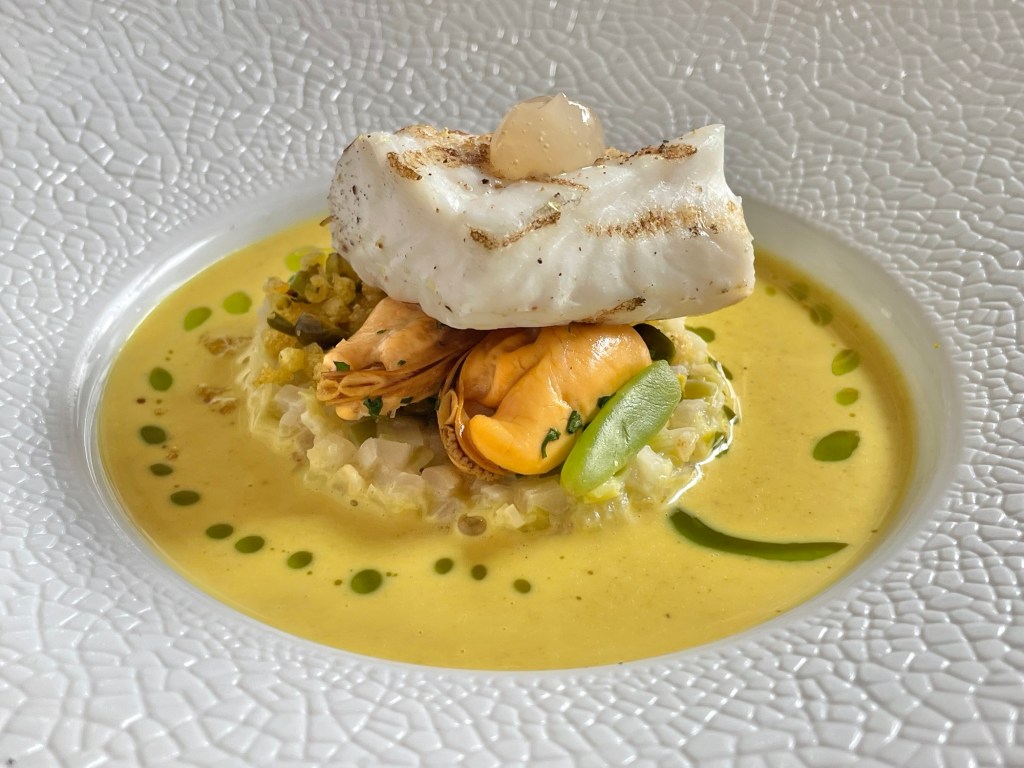
Next was the best dish: perfectly cooked plaice with leeks, lime jelly, and Mouclade, which is mussels with a creamy saffron sauce from Charente-Maritime in France. This paired very nicely with the 1959 Riesling Auslese, as well as with the 1982 Gewurz.
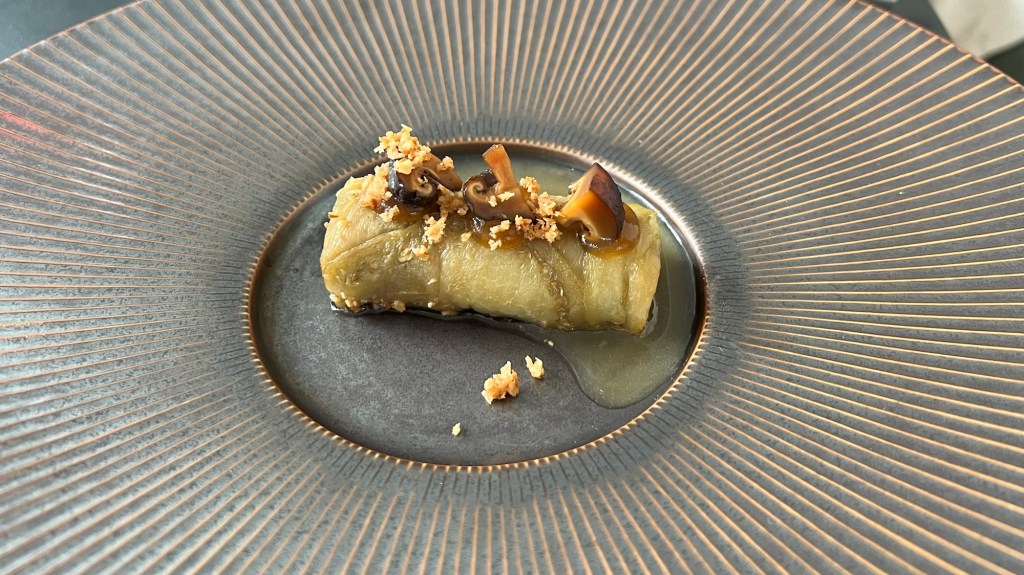
Next was eggplant with shiitake mushrooms and a sweet and sour ponzu sauce. This would also pair well with some of the Rieslings.

The main course was backstrap of roe deer venison with a gyoza stuffed with meat from the shoulder of the roe deer, cauliflower, and jackfruit. According to the menu there are cassis berries and oil from the branch of the cassis, but that didn’t stand out for me. The venison was perfectly tender and medium rare.
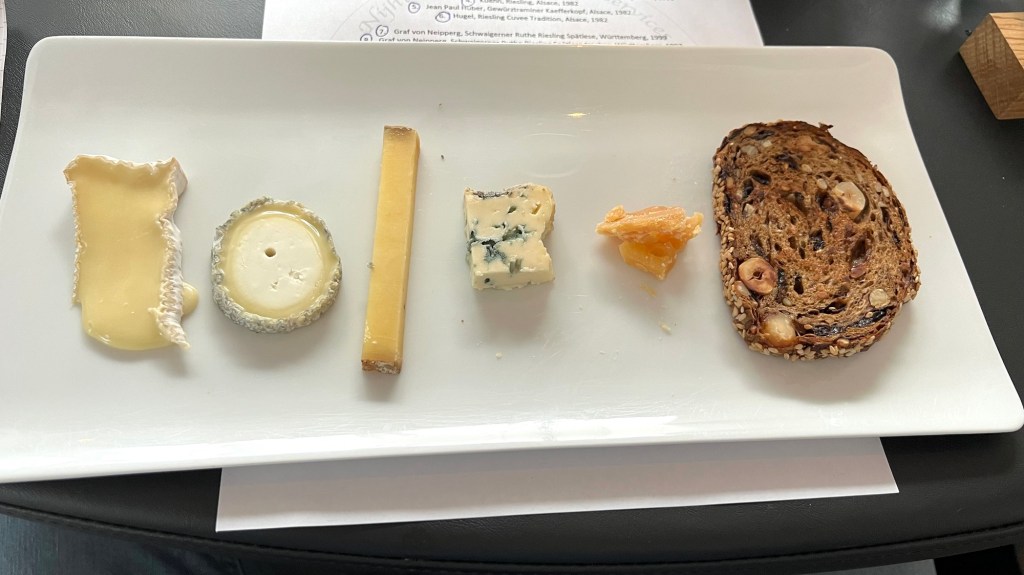
We ended with cheese instead of dessert, to pair better with the final flight of wines. A white mold similar to raw milk Brie, a soft goat cheese, 4-year old Comté, blue cheese, and 8-year old Gouda.
The service was excellent and the food very nice. The restaurant is hoping to get its first Michelin star, let’s see what happens.


What fun! Those bottles are beautiful! As is the food.
LikeLiked by 2 people
Nebbiolo is a varietal I really enjoy, and what an amazing experience. I am lucky enough to have a friend who owned a wine estate, and tasting old wines is something we do quite often as he has a lot of bottles from when his father was the winemaker. I will look at the restaurant when we come over next year for our annual visit.
LikeLiked by 2 people